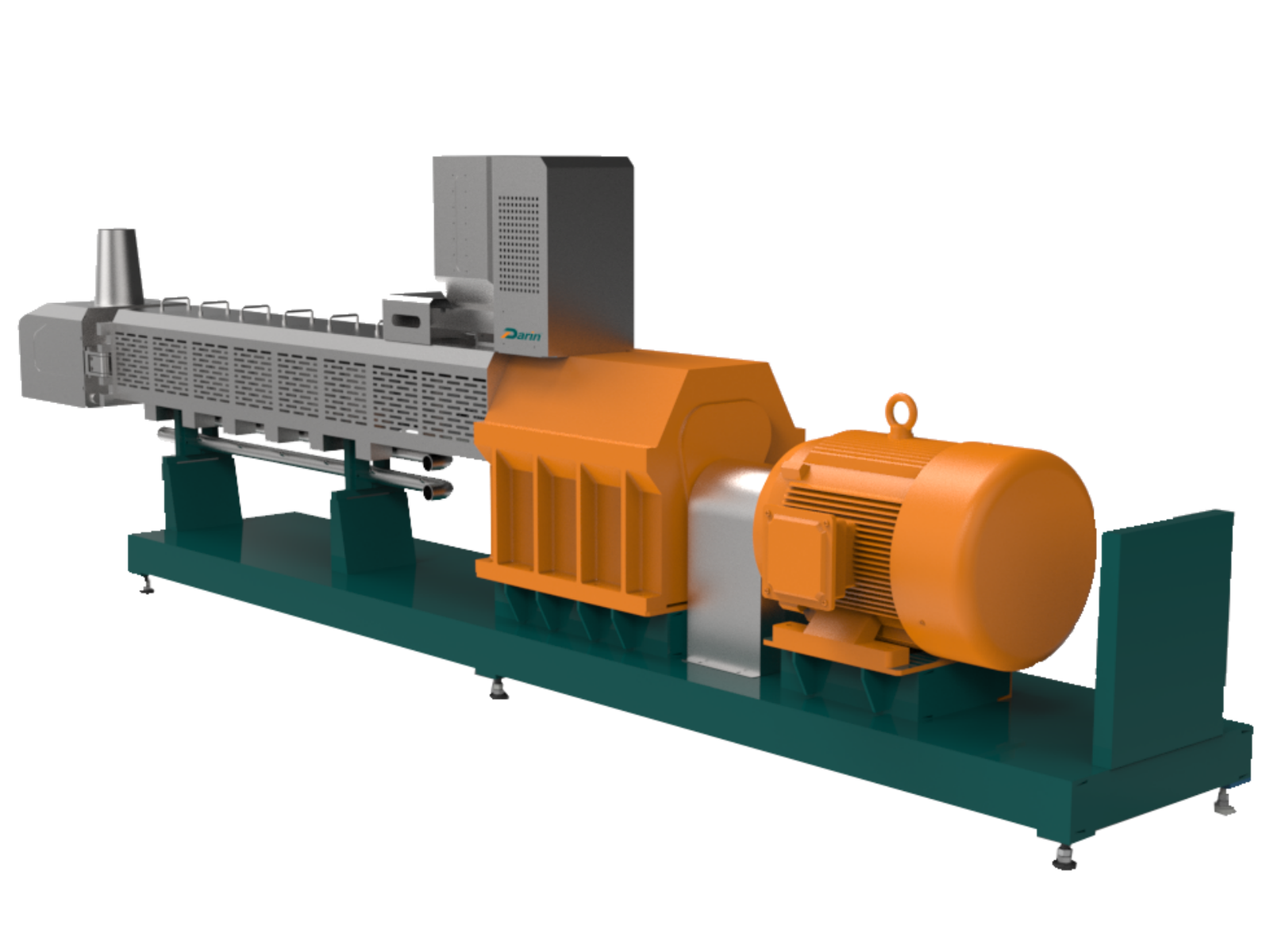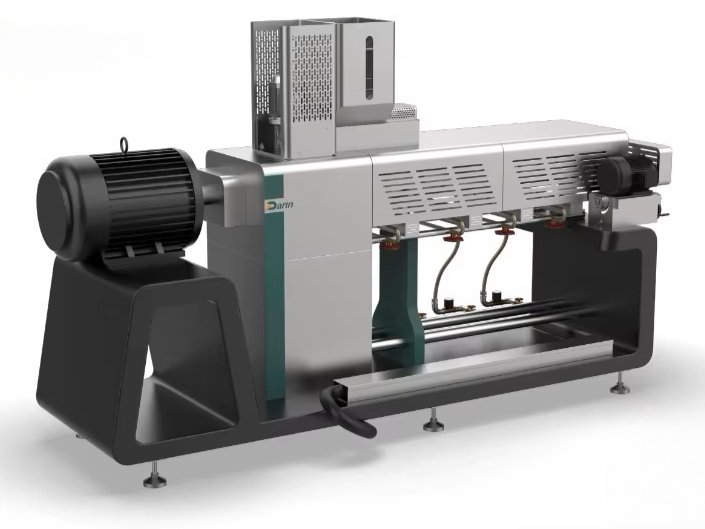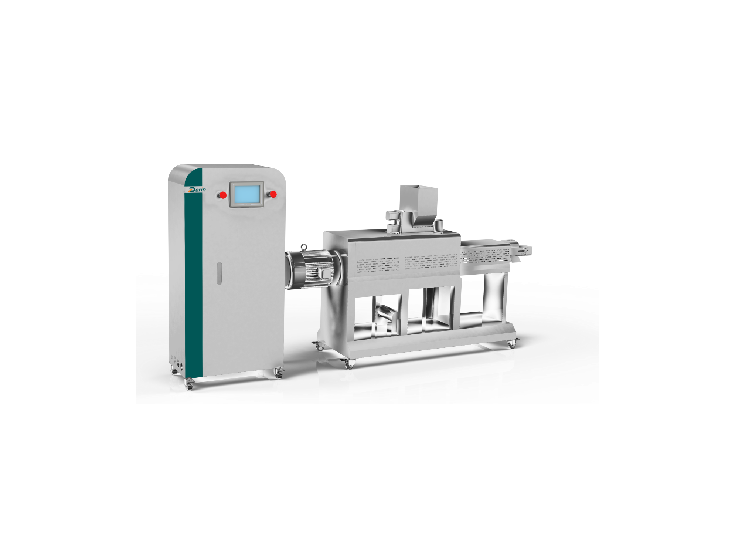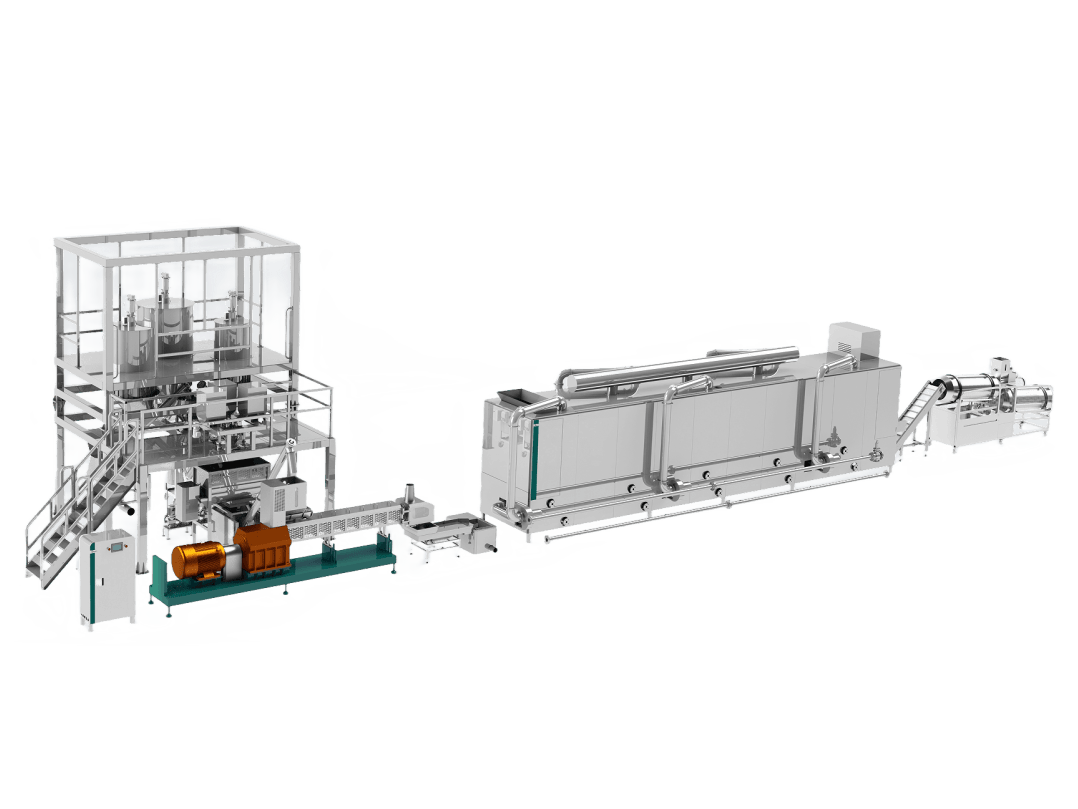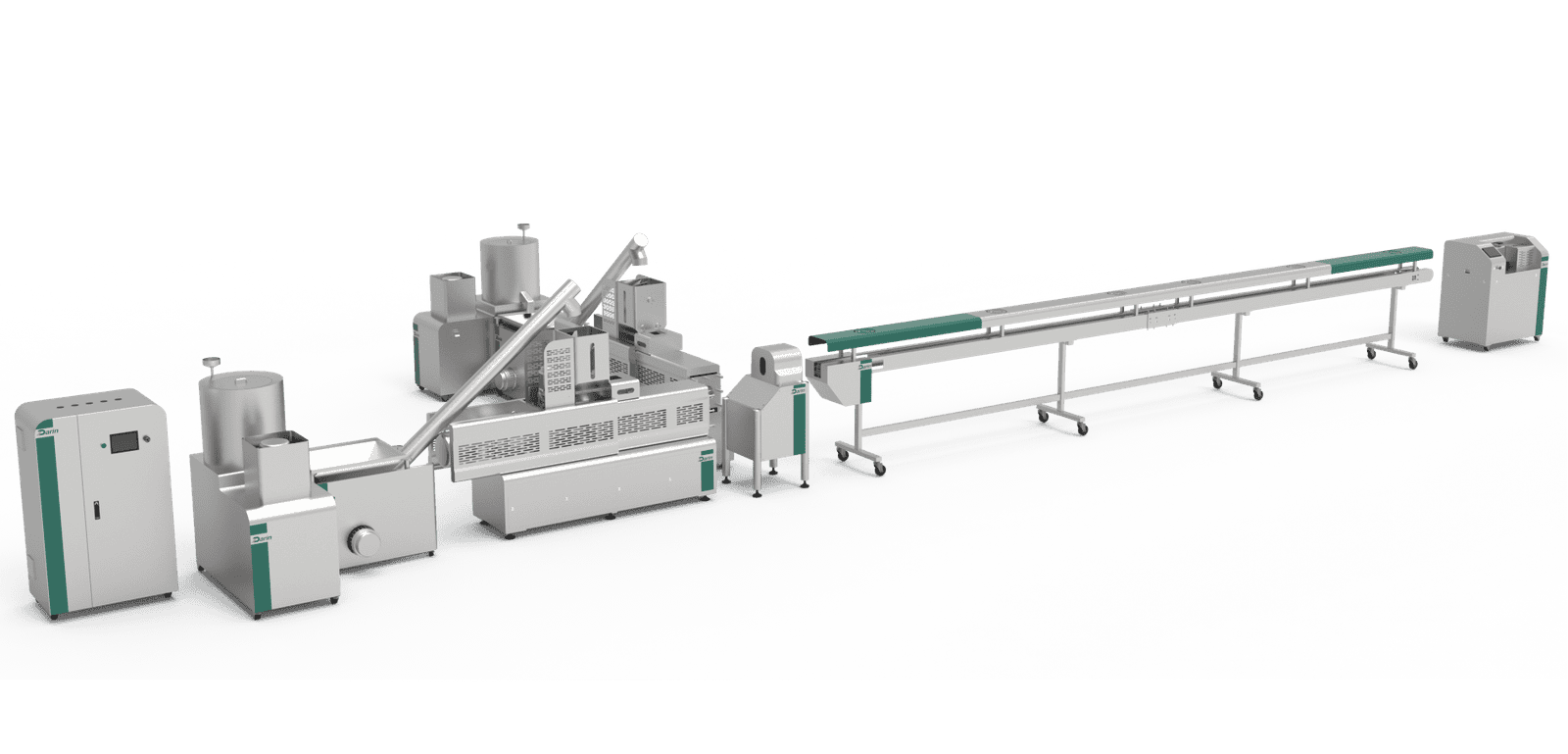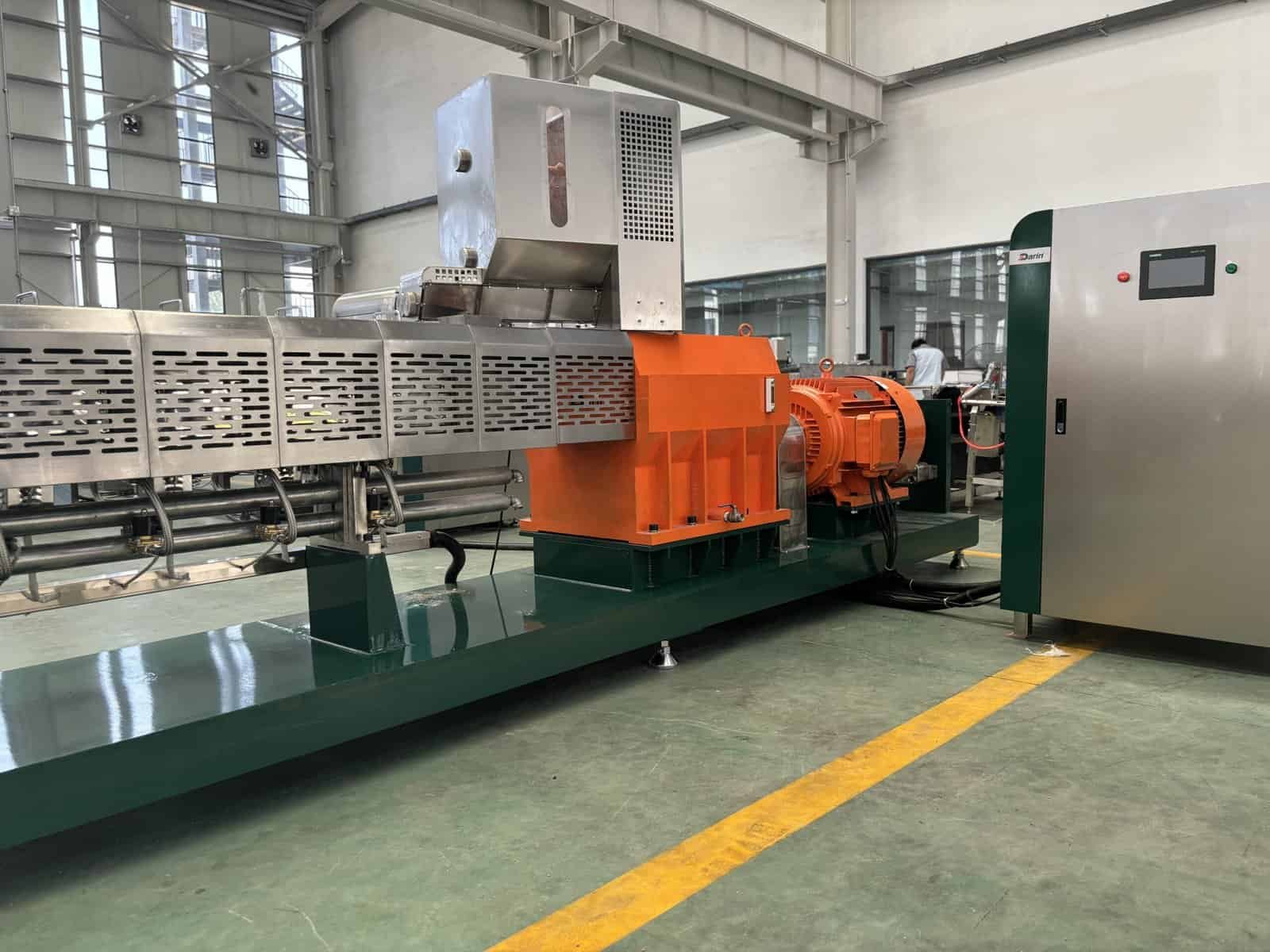
Twin-screw food extruders are central to modern food processing lines—producing everything from pet food and snacks to textured protein. But behind their high-performance capabilities lies a question that is often crucial for manufacturers: how much energy do these machines consume? Without a clear answer, producers risk underestimating operating costs, straining power supply systems, or missing key opportunities to improve energy efficiency. Thankfully, understanding the energy profile of twin-screw extruders allows for informed planning, optimized production, and long-term cost savings.
A typical industrial twin-screw food extruder consumes between 30 to 500 kilowatts (kW) of electrical energy depending on its size, capacity, application, screw design, and material formulation. Most medium-scale systems run at 75–150 kW during operation. Energy usage is influenced by motor power, barrel heating elements, cooling systems, feeding units, and downstream equipment.
If you're evaluating production costs or planning your plant's power supply, read on. We'll break down real consumption ranges, factors affecting energy draw, and how to optimize energy usage.
\
Twin-screw extruders consume significantly more energy than single-screw extruders.Verdadeiro
Due to their dual-drive configuration, torque-sharing design, and typically higher throughput, twin-screw extruders demand more electrical energy than single-screw counterparts.
🔧 Factors That Influence Energy Consumption in Twin-Screw Extruders
1. Installed Motor Power
Most energy in a twin-screw extruder is drawn by the drive motor. Depending on application size:
| Tamanho da extrusora | Installed Motor Power (kW) | Produção (kg/h) | Typical Application |
|---|---|---|---|
| Lab-scale | 3–11 kW | <50 | R\&D, universities |
| Pequena escala | 15–45 kW | 100–500 | Snacks, breakfast cereals |
| Mid-scale | 55–132 kW | 500–1500 | Pet food, puffed snacks |
| Em larga escala | 160–500+ kW | 2000–10000+ | High-volume protein, aquatic feed |
- Motor efficiency (often above 90% in modern systems) also affects actual energy draw.
- Load ratio (percentage of motor usage during actual operation) matters: many extruders run between 60–90% of motor capacity.
2. Heating Elements and Barrel Zones
Extruders use electric heaters to control process temperatures:
- Each barrel zone (typically 5–12 zones) uses separate electric heating coils.
- Average energy per zone: 3–10 kW depending on zone length and temperature target.
- For a 7-zone extruder, heating demand can range from 20 to 70 kW total.
| Barrel Zone Count | Total Heating Power (kW) |
|---|---|
| 5 zones | 15–40 kW |
| 7 zones | 20–70 kW |
| 10+ zones | 40–100+ kW |
Tip: Preconditioning systems (e.g., steam conditioners) may reduce in-barrel heating demand but increase steam energy consumption.
3. Feeding System and Auxiliary Equipment
- Gravimetric or volumetric feeders: Usually consume 0.5–2.0 kW per unit.
- Cutting systems, conveyors, and dryers downstream also draw power.
- A full extrusion line’s total power = extruder power + downstream equipment (can double total system energy).
4. Material Characteristics and Recipe Formulation
- High-fat or high-moisture inputs generally require lower energy to process.
- Dense starches and protein blends (like soy TVP or dog food) demand higher torque and longer residence time.
| Input Type | Relative Energy Demand |
|---|---|
| Corn grits, rice | Baixo |
| Isolado de proteína de soja | Médio |
| Wheat gluten blends | Elevado |
| Fiber-rich byproducts | Muito elevado |
\
Moisture content of feed material has no effect on energy consumption.Falso
Moisture content greatly influences energy usage—higher moisture reduces friction and torque requirements, decreasing total energy demand.
⚡ Energy Consumption Examples
✅ Case Study: Pet Food Production Line (Darin Machinery DSE-65)
- Extruder Type: Twin-screw, 65mm screw diameter
- Motor: 75 kW main drive
- Heating Zones: 6 × 5 kW = 30 kW
- Feeder & cutter: 3 kW combined
- Total Draw at 85% load: ≈ 90–95 kW
- Rendimento: 500–800 kg/h
- Specific Energy Consumption (SEC): \~0.12–0.18 kWh/kg
✅ Case Study: TVP (Textured Vegetable Protein) Line
- Extruder: Twin-screw, 100mm
- Main Motor: 160 kW
- Barrel Heating: 8 zones × 7 kW = 56 kW
- Cooling + Feed: 4 kW
- Total Operational Load: 180–200 kW
- Output: \~1500 kg/h
- SEC: \~0.13 kWh/kg
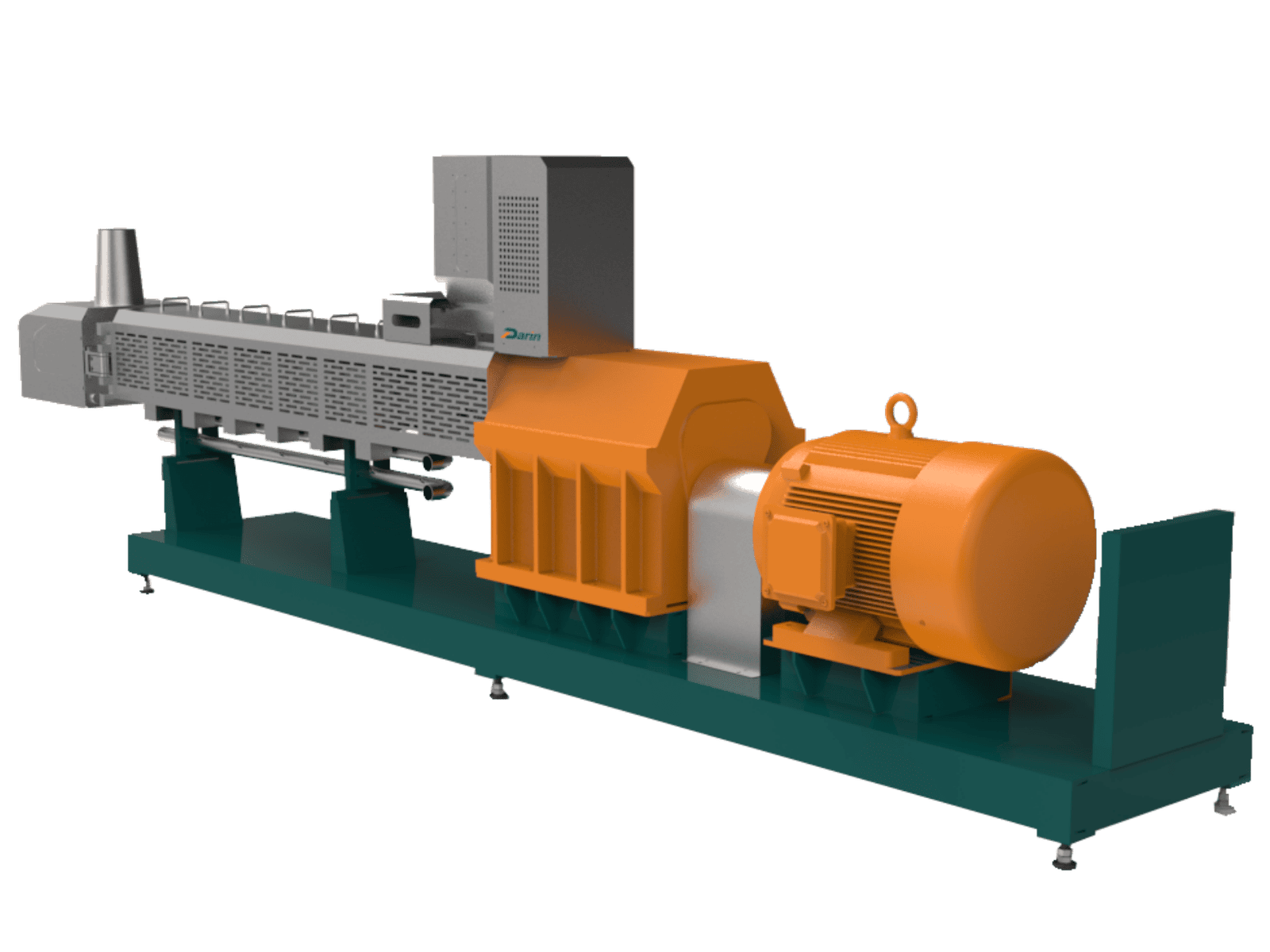
📈 How to Estimate Energy for Your Twin-Screw Extruder?
Use this energy estimation formula:
Total kWh per hour = Motor power (kW) × Load Factor + Heating power (kW) + Feeder + Auxiliary (kW)Then calculate specific energy (SEC):
SEC (kWh/kg) = Total kWh per hour ÷ Output in kg/h| Componente | Formula Input | Example (Mid-Scale Line) |
|---|---|---|
| Potência do motor | 110 kW | 110 |
| Load Factor (70%) | 0.7 | 77 |
| Potência de aquecimento | 40 kW | 40 |
| Auxiliaries (Feeder/Cutter) | 3 kW | 3 |
| Total kWh per hour | — | 120 kWh |
| Saída | — | 1000 kg/h |
| SEC | — | 0.12 kWh/kg |
🔋 Energy-Saving Strategies for Twin-Screw Extruders
- Use VFD Drives (Variable Frequency Drives): Optimize motor RPM and reduce idle load.
- Improve Insulation: Prevent heat losses around barrel zones.
- Switch to Induction Heating: More efficient and responsive than resistance heating.
- Use Preconditioners: Reduce barrel heat load and motor torque needs.
- Manutenção de rotina: Prevent screw wear and barrel friction spikes.
- Choose Right Screw Design: Minimize torque and pressure build-up.
- Load Monitoring & Automation: Detect and adapt to real-time demand patterns.
\
Energy cost is a negligible factor in extrusion line ROI.Falso
Energy costs are often the second largest operational expense after raw materials in extrusion operations, especially for large-scale 24/7 production.
📊 Comparison: Single-Screw vs Twin-Screw Extruder Energy Use
| Parâmetro | Parafuso único | Parafuso duplo |
|---|---|---|
| Motor Power (typical) | 15–55 kW | 30–500+ kW |
| Energy per kg of output | 0.08–0.12 kWh/kg | 0.12–0.25 kWh/kg |
| Flexibility & Recipe Control | Limitada | Elevado |
| Throughput Range | Estreito | Largo |
| Suitable for Complex Recipes? | Não | Sim |
✅ Final Thoughts
Twin-screw extruders are powerful, flexible, and indispensable in modern food processing—but their energy usage must be understood and managed. By selecting the right capacity, optimizing configuration, and applying energy-saving measures, producers can balance performance with sustainability and cost-efficiency.
📩 Contact Us for Custom Energy Analysis
Darin Machinery specializes in designing energy-efficient twin-screw extruders for pet food, snacks, TVP, and more. Contact our technical team to evaluate your specific application and get a tailored power profile that meets your output goals while minimizing energy waste.
👉 Correio eletrónico: darin4@darin.cn
👉 Website: https://petreatsmachine.com/
👉 Request a quote or consultation today!
5. Perguntas frequentes
Q1: How much energy does a twin-screw food extruder typically use?
A1: A twin-screw food extruder generally consumes between 30 kWh to 200 kWh, depending on its capacity, material throughput, and motor power. Small-scale extruders for lab or R&D use may require as little as 5–20 kWh, while large industrial models processing several tons per hour can exceed 150 kWh. Factors such as screw diameter, length-to-diameter (L/D) ratio, and process settings also influence consumption.
Q2: What factors influence the energy consumption of twin-screw food extruders?
A2: Key factors include:
- Motor size and efficiency (larger motors draw more power),
- Screw speed and torque output,
- Material type and moisture content,
- Die configuration and resistance,
- Process temperature and pressure settings,
- Operational time and production load.
Optimization in each area can significantly reduce energy use.
Q3: How can I calculate the operating cost of a twin-screw food extruder?
A3: To calculate operating cost:
- Determine kWh usage per hour (from technical specs or a power meter),
- Multiply by hours operated per day, then
- Multiply by your local electricity rate per kWh.
Example: If your extruder uses 100 kWh and runs for 8 hours/day at $0.10/kWh, daily cost = $80.
Q4: Is a twin-screw extruder more energy efficient than a single-screw extruder?
A4: Twin-screw extruders often consume more power but offer higher productivity, better control, and uniform mixing, levando a greater overall efficiency per kilogram of output. They're especially efficient in high-moisture, complex formulation, or multifunctional processing setups.
Q5: How can energy usage be optimized in twin-screw extrusion?
A5: To optimize:
- Use energy-efficient motors (IE3 or IE4),
- Maintain proper screw configuration for your recipe,
- Reduce unnecessary torque and pressure through better die design,
- Implement PLC control for precise temperature and motor adjustments,
- Regularly maintain components to avoid mechanical losses.
Energy monitoring systems can also help fine-tune usage based on real-time data.
6. Referências
- Twin-Screw Extruders – Energy Consumption Overview – https://www.sciencedirect.com/topics/engineering/twin-screw-extruder - ScienceDirect
- Extrusion Energy Optimization – https://www.extru-techinc.com/articles/energy-optimization – Extru-Tech
- Comparative Study of Single vs. Twin-Screw Extruders – https://www.researchgate.net/publication/347548901 - ResearchGate
- Guide to Efficient Extrusion – https://www.thermofisher.com/blog/materials/5-ways-to-reduce-energy-use-in-extrusion/ – Thermo Fisher
- Practical Guide to Twin-Screw Extrusion – https://www.polymerextrusionguide.com – Polymer Extrusion Guide
- What Drives Extruder Power Usage – https://www.ptonline.com/articles/tips-and-techniques-energy-management-for-extruders - Tecnologia dos plásticos
- Food Extrusion and Energy Use – https://www.springer.com/gp/book/9783030419616 – Springer
- Twin-Screw vs. Single-Screw Energy Metrics – https://www.azom.com/article.aspx?ArticleID=19708 – AZoM
- Design and Operation of Twin-Screw Extruders – https://onlinelibrary.wiley.com/doi/book/10.1002/9781119609020 – Wiley
- How to Save Energy in Extrusion Processes – https://www.processingmagazine.com/process-equipment/energy-efficiency/article/15583746 – Processing Magazine


